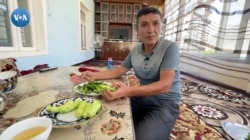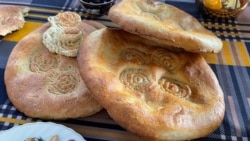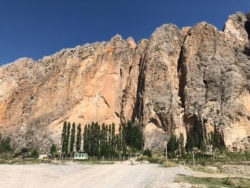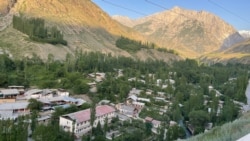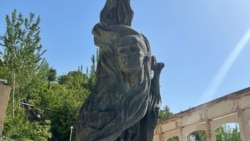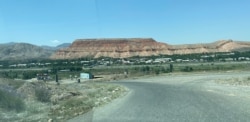The collapse of the Soviet Union left thousands of people living in enclaves — portions of one country surrounded by another. For the residents, this presents unique challenges; merely to visit their own nation’s capital requires them to carry a passport and cross foreign territory.
Uzbekistan, celebrating its 30th anniversary of independence, maintains four exclaves in the heart of Central Asia’s Ferghana Valley. All are within the borders of neighboring Kyrgyzstan. The two largest, Sokh and Shohimardon, are proudly Uzbek. Yet for decades, the government in Tashkent did not invest in them.
Still, Numonjon Eraliyev, a greenhouse manager in Sokh, insists that “we are not as isolated as people assume.” He treats his guests to freshly cut cucumbers — the emerald-green bounty of a hilly area where water is drawn from 107-meter-deep wells.
For the second time, VOA had near-exclusive access to these unique exclaves. This time, the residents of Sokh are more vocal about one thing: They want a visit from President Shavkat Mirziyoyev, who is running for a reelection that is virtually certain.
“He travels around the country. … We are Uzbekistan too,” Eraliyev said.
Sokh, Uzbekistan’s ethnic Tajik district
Founded in the 1940s, Sokh is ethnically Tajik but was given by Moscow to the Uzbek Soviet Socialist Republic. Located at the foot of the Pamir-Alay mountains, it is the largest exclave in Central Asia with more than 80,000 people and boasts a history that spans centuries. Its people resisted the Bolsheviks during the 1920s and 1930s. In the 1990s, it became a suspected hideout for armed Islamic extremists.
Mirziyoyev has prioritized resolving border issues. In 2019, locals told VOA that Kyrgyzstan was deliberately blocking the most direct road between Sokh and the rest of Uzbekistan. But Tashkent negotiated with Bishkek, and in the spring of 2021, that road opened, allowing access to Sokh in one-fourth of the time. Traders in Sokh bazaar told VOA they can now sell fresh vegetables, fruit, and other goods delivered from the mainland every day.
“Sokh people are known for their tenacity and patience. Our district has gotten much attention from the central and regional administrations,” said Saidbahrom Saidmusayev, Sokh’s mayor.
Saidmusayev, who once helmed Sokh’s police, was appointed as mayor following an Uzbek-Kyrgyz water dispute in 2020 that destroyed several households and led to the conviction of 22 men for instigating public disorder and attacking officials. Mirziyoyev dispatched his prime minister, Abdulla Aripov, to assuage an angry Sokh citizenry with promises of investment, educational and job opportunities, and new infrastructure.
The government also promised an airport, a prospect welcomed even by those who will supply the land for it.
“The future is here,” said Valijon Rahmonov, a potato farmer. He has lost half of his cropland to airport construction but is ready to welcome travelers so long as he can retain the rest.
“Mirziyoyev should listen to us, ordinary folks. Sokh is a great place to live, so we want simple things — better access to the mainland to enable growth, education and opportunity,” he said.
Access to Sokh is restricted. Only Uzbek and Kyrgyz citizens can travel there without a special permit. That makes it and other exclaves seem incredibly remote. But a visiting reporter found its people to be better informed and more politically aware than many others in Uzbekistan and Kyrgyzstan.
“For me, Sokh seems like a small country with big issues, with dozens of villages, each with its happy stories, as well as injustices and ignorance,” said Kamoliddin Azizov, a journalist turned activist. Azizov says Sokh’s residents are proud citizens who welcome the increased focus from Tashkent.
Because life involves a constant crossing of borders, Azizov said, people adjust to challenges. For example, nearly half of Sokh residents are fully vaccinated against COVID-19, a higher uptake than in many parts of Central Asia.
“Forty percent of us are 18 to 30,” said Ravshan Komilov, a youth leader, and many are eager to work abroad and see the world. “There are jobs here, but you can't stop young people,” Komilov added. “Each day involves carrying our passport between two states, the one that surrounds us, and the one we belong to.”
At least half of the households have a family member working elsewhere, mainly in Russia, whose remittances help build private houses and businesses. But the enclave also hosts bold new ventures, such as a collective of seamstresses who got their start with state support and now earn a modest income. Some are single mothers; others have husbands working in Russia.
In a new economic zone, 22-year-old Manuchehr Mirzobekov runs his family’s business. The plant produces construction materials in high demand across Central Asia. He proudly shows off new and expensive equipment from China and aims to employ hundreds someday.
“Our future is here in Sokh,” he said.
Shohimardon, empty gem
Nearby Shohimardon tells another story. The second-largest Uzbek exclave in Kyrgyzstan, just an hour’s drive from the center of Fergana, it lacks Sokh’s momentum and buzz. Shohimardon’s population of about 10,000 people enjoys magnificent waterfalls and rivers astride a valley in the Pamir-Alay. Perched 1,500 meters above sea level, locals and visitors alike gush over the beauty of the “Uzbek Switzerland.”
This former Soviet resort once housed sanatoriums, camps, dachas and facilities catering to officials and apparatchiks.
Uzbek journalist Sharifa Madrahimova recalls a childhood of summers filled with family rituals and fun.
“The place used to be crowded, especially this park,” she said, pointing to a now rundown structure by the Aksu river. With nary a reveler in sight, it is a partyland only for grazing cows and goats.
In summer 2019, VOA saw a lively bazaar, and cafes and traditional teahouses on its central street. Now, it is a ghost town.
“Without visitors, even mother nature seems sad,” said an elderly Uzbek traveler. “I got a room at a private house for 10,000 soms (under $1) a night. There is nothing here. Why isn’t government investing? Such a beautiful place, desperately in need of renovation and attention.”
Travelers to Shohimardon, like Sokh, need a passport and COVID-19 PCR test. And since Uzbekistan’s new passport is expensive, Madrahimova said, “most of us travel to closer locations with cheaper and easier access.” She is returning to Shohimardon after nearly 30 years.
On the exclave’s hilly streets, the powerful sound of water echoes. One gets so used to it that the silence is strange once you leave the area. There are no modern hotels. And as you drive higher up the main road, you pass old Soviet buildings that still lodge regional agencies, such as the tax office, factories, security services, universities and trade associations. But these dull gray buildings do not distract from the mountain scenes.
Gayratjon Mamatqulov of the Ferghana Consumer Rights Association blamed COVID-19 for the current sense of emptiness.
“People are not traveling, and those who want to come must take a test, which is not free, and obtain new passports, since you cross a foreign country to see these exclaves,” Mamatqulov said.
The local tourism office recorded more than 1,000 Uzbek and Kyrgyz visitors to Shohimardon in the first half of 2021, five time less than in 2019.
Shohimardon’s museum, another Soviet leftover, showcases the legacy of Hamza Hakimzoda Niyoziy, a Bolshevik stoned to death by the local resistance in 1929. His monument still stands, reflecting the tragic story of the educator, playwright, poet and composer.
A nearby Islamic prayer house claims the Prophet Muhammad’s son-in-law Ali as a visitor. Some even believe he died and was buried there. It’s another empty place of pilgrimage today.
“We miss people,” said the local imam, who lives next door. “Shohimardon did not experience much COVID, but we feel the pandemic’s impact.”
Mamatqulov hopes Tashkent will shower Shohimardon with the same attention it is giving Sokh.
“The government definitely sees potential, and this exclave should benefit from the arrival of internet and better relations with Kyrgyzstan,” Mamatqulov said.
Ferghana’s deputy governor, Khurshidbek Ahmedov, who returned to Uzbekistan to help the county develop, aims to improve tourism and attract investment to the exclaves.
“We are working closely with Bishkek on this. The roads to Uzbek exclaves will be repaired, with rest stops in Kyrgyzstan,” Ahmedov said.
At present, Uzbeks driving through Kyrgyz territory never stop. They fear the Kyrgyz won’t want them, and VOA talked to several travelers who complained of harsh treatment by border and customs officials. Uzbek travelers have grievances with the Kyrgyz; Kyrgyz blame the Uzbeks. Officials insist that travelers with proper documentation have no problems crossing. VOA saw no long lines at any posts, which are open from dawn to dusk.
Mamatqulov, who regularly visits the exclaves, asserts they face the same challenges as other regions in Uzbekistan. People need good schools, better paying jobs, better conditions for business, reliable transportation and modern infrastructure.
“They know they can’t really have it all. They know they must work for them. But it’s harder in the exclaves and it’s always been that way,” he said.





